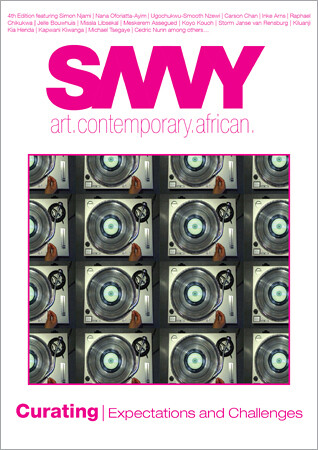“Curating: Expectations and Challenges”
SAVVY | art.contemporary.african.
ISSN 2191-4362
We are proud to announce the 4th edition of the SAVVY Journal dedicated to “Curating: Expectations and Challenges.”
Contributors in this issue deliberate on current curatorial theories and practices in the framework of Contemporary African Art, wherein ideologies and philosophies, sciences and economics, ethics and aesthetics of the curatorial practice and the semantics of exhibition making are elaborated upon, and framed around questions like:
What are the prominent issues of display and curating that inform and condition exhibition-making? What is the understanding of authorship in this context? What is the relationship, point of intersection and repulsion between artistic and curatorial practice as instigators of meaning in an exhibition context? How does the curator serve as power broker between society, artists, institutions, community, politicians and financiers? Is there a cognizable methodology in curating Contemporary African Art exhibitions with regard to Western or non-Western curators?
In the essay “Of Curating and Audiences. Art at Work,” Simon Njami reflects on the target and audience of an exhibition, especially outside of the traditional places of consecration, like museums and biennials. Ugochukwu-Smooth Nzewi‘s ”Curating Africa, Curating the Contemporary: The Pan-African Model of Dak’Art Biennial” gets to the crux of the Dak’Art Biennial’s vision of mediating international contemporary art with a curatorial practice that advances pan-Africanism as a point of departure. Perrin Lathrop picks up on the sprouting of biennials in Africa in “Localising the Global Biennial? The Encounters of Bamako: African Biennial of Photography, 1994-Today.” Still in the context of biennials on the African continent, Carson Chan gives an insight to the yardsticks and lodestars in the preparatory phase of the 4th Marrakech Biennale “Higher Atlas” in “Let Me Entertain You: A Consideration of Context and Audience in Curating the 4th Marrakech Biennale.” The questions of the politics of curating and the tension between the artistic positions on the continent and those in the Diaspora are tackled by Raphael Chikukwa in “Confronting the Unevenness in the Politics of Curating Contemporary African Art: Questions of Blockbuster Exhibitions and their Western Influences.” Jelle Bouwhuis gives his view as to “What is a ‘Postcolonial Exhibition?” The evolution of artistic positions and art spaces in Africa is aptly articulated by Nana Oforiatta-Ayim in her paper “Speak Now.” Anne Szefer Karlsen and Nico Anklam round up with further salient essays.
This edition also throws spotlights on Yassine Balbzioui, Dalila Dalleas, Theo Eshetu, Tracey Rose, Bouchra Khalili, and Santu Mofokeng for the German Pavilion of the 2013 Venice Biennial, as well as Chika Okeke-Agulu‘s poem dedicated to Amal Kenawy. The pulsating features in this issue will drive you through a parcours of thrilling articles by Inke Arns on NSK interventions in Lagos, Caroline Hancock on Kapwani Kiwanga, Rachel Nelson on Kiluanji Kia Henda, Clara Giacalone on Zoma Contemporary Art Center and Andrea Heister on Koyo Kouoh. Further insights are limned in exclusive interviews with artists, curators or academics like Michael Tsegaye (Missla Libsekal), Cedric Nunn, Storm Janse van Rensburg and Yves Chatap (Bonaventure Soh Bejeng Ndikung), and Meskerem Assegued.
To stay tuned please subscribe here.
Happy reading!
Bonaventure Soh Bejeng Ndikung | Editor-in-chief
SAVVY Journal will like to use this opportunity to welcome the members of its advisory board: Simon Njami,Olu Oguibe, Ntone Edjabe, Christian Kravagna, Elvira Dyangani Ose, Sean O’Toole, Paul Goodwin, Dominique Malaquais and Raimi Gbadamosi.
Team
Bonaventure Soh Bejeng Ndikung | Editor-in-chief
Andrea Heister | Deputy editor-in-chief
Clara Giacalone | Editorial Assistant
Ato Malinda | Guest Editor
Graphic Design – Martina Sophie Pankow | Web – Soavina Ramaroson
SAVVY Journal, though primarily and online magazine, offers a limited print version (50 copies)—acquirable for 50 EUR/journal.
Acknowledgements: Goethe Institute Johannesburg and Goethe Institute Lagos (for their kind support), all authors, designers, translators, proofreaders and editors of this edition.


